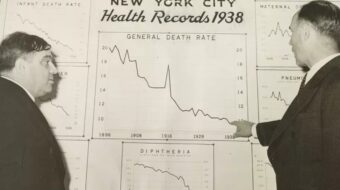 Director/co-writer and Oscar nominee Angus Gibson’s Back of the Moon is another example of why I love PAFF—the Pan African Virtual Film + Arts Festival. If not for this festival film buffs like moi probably would never have heard of, let alone had the opportunity to see, this highly entertaining South African movie. Moon is a gangster film in the way that Jean-Luc Godard’s 1959 New Wave Breathless is. Sure, Moon definitely has genre conventions of mobster movies, with references to other crime pictures. For example, the chilling, cunning Ghost (the outstanding Lemogang Tsipa) slashes the nose of a white journalist with a knife, an obvious wink and nod to 1974’s Chinatown, wherein director/actor Roman Polanski likewise sliced Jack Nicholson’s nostril. Gibson also refers to the 1942 North Africa-set Humphrey Bogart Warner Bros. classic, as Moon’s nightclub, where some of the action takes place, is named “Casablanca.”
Director/co-writer and Oscar nominee Angus Gibson’s Back of the Moon is another example of why I love PAFF—the Pan African Virtual Film + Arts Festival. If not for this festival film buffs like moi probably would never have heard of, let alone had the opportunity to see, this highly entertaining South African movie. Moon is a gangster film in the way that Jean-Luc Godard’s 1959 New Wave Breathless is. Sure, Moon definitely has genre conventions of mobster movies, with references to other crime pictures. For example, the chilling, cunning Ghost (the outstanding Lemogang Tsipa) slashes the nose of a white journalist with a knife, an obvious wink and nod to 1974’s Chinatown, wherein director/actor Roman Polanski likewise sliced Jack Nicholson’s nostril. Gibson also refers to the 1942 North Africa-set Humphrey Bogart Warner Bros. classic, as Moon’s nightclub, where some of the action takes place, is named “Casablanca.”
The film’s title, however, takes its name from the bordello in Johannesburg’s Sophiatown district where much of the story unfolds circa 1958. Maxwell, aka Badman (Richard Lukunku, who has acted in South African productions and the Starz pirate series Black Sails), is the leader of the violent Vipers, a gang that makes the Crips and Bloods look like social workers in comparison. Having said that, Maxwell is a complex if not contradictory character. On the one hand, he is indeed a tough hombre who brawls with the boxing champion Strike (South African actor S’Dumo Mtshali).
On the other hand, Maxwell speaks French (his mother was from the “Belgian” Congo), reads Ralph Ellison’s novel about racism Invisible Man, and makes allusions to the Congolese independence leader Patrice Lumumba (whom, tellingly, Lukunku portrayed in 2016’s The Siege of Jadotville). So Lukunku depicts Maxwell as also being a man of culture, consciousness, and conscience. Perhaps being a hoodlum is the only way he can rise and have social status, power, and money under apartheid?
The gang boss’s intellectual aspirations are probably the reason why the ruthless Ghost plots to depose Maxwell and take over the helm of the Viper criminal enterprise himself. The crafty Ghost schemes to do so by kidnapping the beautiful torch singer Eve Msomi (Moneoa Moshesh)—the girlfriend of the abusive, jealous heavyweight Strike—while she performs onstage at the Casablanca, and then guilefully delivers her to Maxwell, so the possessive Strike can retaliate against and eliminate the Vipers’ leader, setting the stage for Ghost’s coronation.
Like the aforementioned Breathless, Chinatown, and Casablanca, Moon is much more than just a crime picture. Like a lot of Film Noir (sometimes written by blacklisted screenwriters), Moon has a political subtext. In Casablanca (not a Noir film per se), Rick had to deal with the Nazis and their Vichy France stooges, and in Moon Maxwell and company have to contend with another vicious form of fascism. Except for some black and white vintage footage that opens the movie, the story transpires in Sophiatown on the day/night before the apartheid regime will forcibly move the Blacks away and relocate them because they are too close to a Caucasian community, so whites can takeover and inhabit this Johannesburg ’hood. (Can you say “gentrification”?)
This puts Moon into a heightened context and gives it a deeper layer of meaning. Frantz Fanon wrote that when the wretched of the Earth are unable to attack the source of their misery, they turn upon each other—but that when Algeria’s war for national liberation began against the French colonizers, the crime rate in the casbah dropped. Director Angus Gibson, who co-wrote Moon with Libby Dougherty, was Academy Award-nominated for the 1996 documentary Mandela, so clearly he knows something about movements for freedom and why Moon repeatedly mentions Lumumba.
The film is also atmospheric with a sexual subtext. Same-sex male oral sex is a leitmotif of emasculation and humiliation in the macho hoodlum demimonde. Interestingly, there is partial male nudity but, as I recall, only suggested female nudity. Cleverly, there is only one sex act depicted or alluded to in the movie that doesn’t abruptly end with a form of coitus interruptus.
Gibson helms with a stylish touch and empowers his cast to deliver captivating performances. As this Film Noirish movie’s lead female, Moneoa Moshesh endows the voluptuous Eve Msomi with a sensitivity so that she is more femme than fatale. Beneath the rough exterior Richard Lukunku’s Maxwell reveals a vulnerability—perhaps the so-called “Badman” isn’t so bad, after all. The most exceptional performance is arguably turned in by Lemogang Tsipa as the menacing, aspiring Viper chief Ghost—imagine Malcolm McDowell’s Droog Alex in 1971’s A Clockwork Orange wearing a sort of zoot suit. Tsipa has acted in South African productions, as well as opposite Chiwetel Ejiofor, who also directed 2019’s Malawi-shot The Boy Who Harnessed the Wind, and in Gavin Hood’s 2015 anti-drone warfare Eye in the Sky, starring Helen Mirren.
This 95-minute movie is in Zulu, with some English and a smattering of French, with English subtitles. With its violence and coercive sex, some may find Moon to be triggering and it is not for children. But adults who enjoy action-packed stories about the underworld and well-made motion pictures with a twist are likely to appreciate this apartheid-era morality tale where the real crime is racist oppression and segregation. The trailer can be viewed here.
This year’s 29th annual Pan African Virtual Film + Arts Festival is taking place Feb. 28-March 14.
For more info about Back of the Moon see here. For info about PAFF see here.












Comments